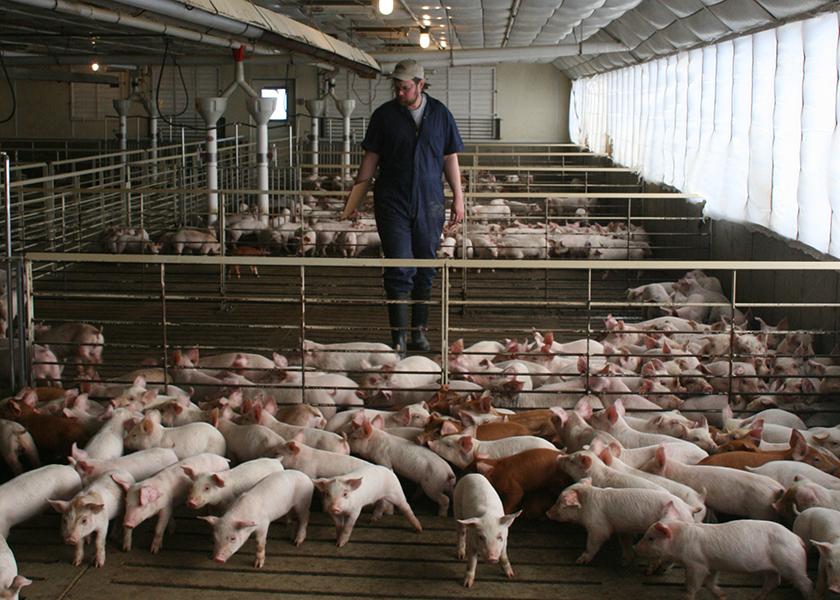How Could PRRS 1-4-4 1C Sneak into Your Herd?

When porcine reproductive and respiratory syndrome virus (PRRSV) 1-4-4 1C appeared in southern Minnesota and northern Iowa in late 2020, dramatic clinical signs on farms raised immediate concern. A second wave of outbreaks in April and May in a wider geography with positive cases in upper Midwest states has kept this virus at the forefront, the Swine Health Information Center (SHIC) reports.
During a webinar, PRRS 1-4-4 Incidence and Response, the SHIC Rapid Response Team shared its investigations into possible ways this virus is spreading.
Presenters included Giovani Trevisan, Iowa State University (ISU)/Swine Disease Reporting System (SDRS); Mariana Kikuti, University of Minnesota/Morrison Swine Health Monitoring Project (MSHMP); Paul Yeske, DVM, of the Swine Vet Center, St. Peter, Minn., and Derald Holtkamp, ISU Veterinary Diagnostic and Production Animal Medicine.
An Ever-Evolving Enemy
Although 1-4-4 is not a new strain, on-farm experience with this new lineage 1C (L1C) variant has shown it results in higher farrow-to-finish mortality, abortions, mummies and slower growth in finishing pigs compared to other PRRSV strains.
Information gathered from upper Midwest veterinary diagnostic labs shows PRRSV lineage detection over time is very dynamic with the L1C variant already becoming the fourth most detected, Trevisan noted. Data submitted to the Swine Disease Reporting System confirms the L1C variant is most frequently detected in the wean-to-market category in Minnesota and Iowa.
Diversity is inherent to PRRSV. Trevisan said this remains true for the L1C variant which is evolving and forming different groups. This strain remains most frequently detected in Iowa and Minnesota, but researchers noted at least seven other states have reported the L1C variant.
Kikuti presented information from MSHMP showing this variant is unusually similar at the ORF5 level between different sites, SHIC reports. She also detailed their case definition saying sequences that were at least 98% similar to any other case sequence were included. As of June 30, a cluster of 259 sequences had been reported. There were 227 sites affected, including 64 breeding herds, 126 growing pig farms, and 37 without information defining their type. But Kikuti mentioned a concern over the lack of standardized nomenclature for whole genome sequences which assures the same case definition is used throughout the industry.
Devastating Clinical Observations
As a practitioner, Yeske has seen the variant’s effects up close. Clinical observations include abortions which continue to be the hallmark of the variant, though the frequency was less in the spring outbreak than last fall. Mortality rates were about the same with both outbreaks. In the farrowing herd, stillborns and mummies were common. Preweaning mortality was as high as 100% for a few weeks this spring. Yeske said they also noticed piglet quality deteriorating rapidly, and higher than normal postweaning mortality.
A Rapid Response from SHIC
The SHIC Rapid Response Team outbreak investigation took place on two farms that broke with the variant in the spring, SHIC reports. Holtkamp set up the team’s work with the farms and emphasized the goal is not assigning blame to anyone on either farm or the system it is part of, rather, to understand weaknesses in biosecurity and then develop plans for improvement.
The Rapid Response Team hazard analysis takes into consideration available epidemiological information including sequencing information as well as timing and location of the first clinical signs of the variant.
In short, the analysis looks for where the farm is vulnerable. Holtkamp described the process as conducting a murder investigation in the middle of a gang fight, meaning there are an extraordinary number of suspects.
The investigation looks at people, equipment, tools, supplies, animals, locations, timing of activities and procedures including the who, what, where and how of each. The Rapid Response Team’s form used for the investigation is available on the SHIC website.
A Review of Risk Factors
Both farms being reviewed were commercial farrow-to-wean farms. On farm one, the first clinical signs were noted on May 9 and included scouring and rough hair coats on piglets in farrowing rooms. On farm two, the first clinical signs were seen on May 29 with sows were off feed in part of the gestation barn.
Four weeks of each farm’s records were analyzed, SHIC reports. On farm one, there were 575 risk events noted. On farm two, there were 580 risk events. The Rapid Response Team rated employee entry and removal of weaned pigs as the highest risk factors on farm one. On farm two, removal of cull sows was the highest risk event. The team noted another concern of employee transfer between farms in the system.
Because PRRSV 1-4-4 1C is more virulent and highly contagious, Holtkamp said any lapse in biosecurity could be an entry point onto a farm. Yeske noted the magnitude of the outbreak waves increased from the fall of 2020 to the spring of 2021, which creates concerns for a wave to occur again this fall. Both Yeske and Holtkamp urge producers to review biosecurity plans now to identify potential areas of entry on farms.
Read More from Farm Journal's PORK:
Biosecurity in the U.S. Pork Industry: Are the Gaps Opening?







